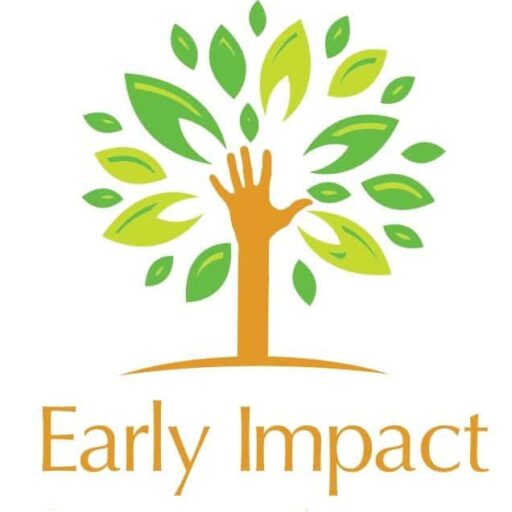Maths is full of patterns, as is the world around us.
An understanding of simple patterns will later develop into children’s understanding of numbers and how the number system works!
It is crucial to let young children experience patterns in many different ways. It should be multisensory – they should paint patterns, dance them, sing them! The more ways they engage with them the better.
In a ten-year career of teaching young children, I have tried numerous strategies to teach patterns.
My favorite 21 have made it to this article! These are the cream of the crop.
I use dough, books, construction toys, loose parts, art, music – whatever I can think of to activate children’s interest and get them learning!
Most of these ideas use simple resources that you probably have already or you can get your hands on quickly. There is a simple version of each activity – but you can also make it much harder as well for older or more skillful children.
So here we go – here are my top 21 pattern activities for children aged 3 to 7…
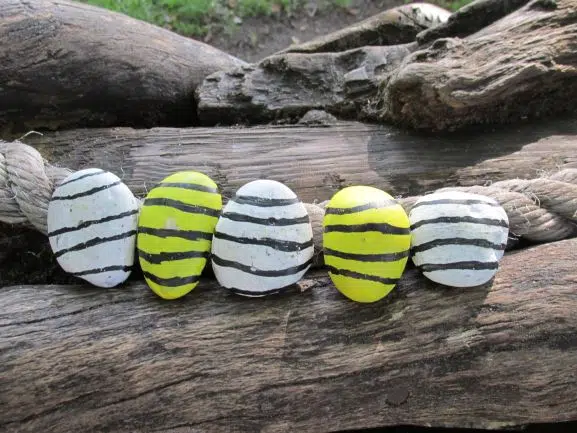
21 Pattern Activities (For Children Aged 3-7)
1.Splat The Dough!
Resources – (Essential) Playdough
(Optional) Shape stampers, mini mallets, goggles
This is number one for a reason!
Get the children to try and make balls of dough and then put them out in a line. The idea is that you splat one ball (press it down), miss the next, then splat the next, miss one…and so on.
You will make a fantastic visual pattern, that is brilliant for kinaesthetic learners because it’s so hands on.
You could extend this in lots of different ways, including:
• Make more complex patterns, such as splat two, miss one, splat two, miss one…
• Use something like dough shape stampers to splat the dough. It could go triangle, square, triangle, square…
• Use mini mallets! Probably a good idea to wear goggles at the same time.
2. Loose Parts Dough
Resources – Playdough, loose parts (e.g. shells, stones, pegs, or others of your choice)
This another really hands-on and visual way of creating patterns.
Get the children to roll lots of balls of dough again, and put them in a line (similar to the last activity).
Now you have a selection of loose parts. What you do is make a pattern by sticking the objects into the dough balls. For example, the pattern might go shell, wood slice, shell, wood slice.
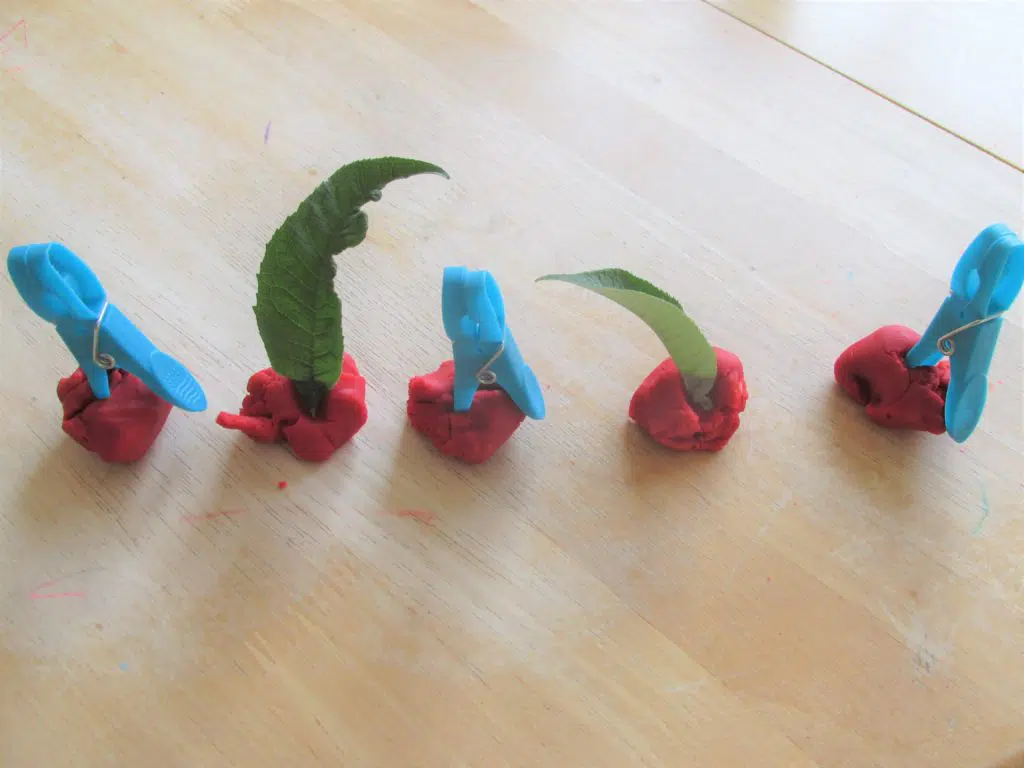
It’s as simple as that!
There are probably lots of ways you can extend this one as well, such as:
• More complex patterns
• Sticking more than one thing into each ball. For example it could be shell, 2 matchsticks, shell, 2 matchsticks
3. Loose Parts Objects
Resources – Loose parts of your choice
Loose parts are a fantastic source of open-ended learning. All you need for this activity is at least 2 different types of random objects.
You could use stones, corks, clothes pins (pegs), sticks, screws, buttons – whatever! To find out the kinds of resources that are great for loose parts play, check out this list of over 100 ideas.
Try making a pattern! It’s that simple.
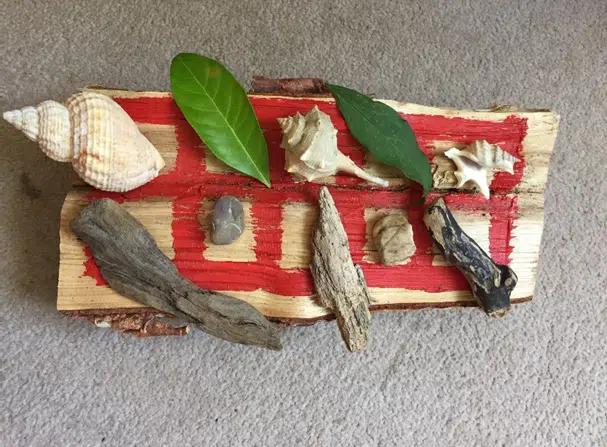
Some ways of really jazzing up this activity include:
• Stick things in the ground! For example, it could be sticks and matchsticks in a pattern – matchstick, stick, matchstick, stick etc
• Have large numbers or letters written on the ground or on big paper. Get the children to put the objects down so they draw the letters or numbers. Things like gems or colored buttons would be brilliant for this
• Use large or small loose parts – for example, some large ones could be planks and tyres
4.Washing Lines
Resources – A piece of string, pieces of colored card OR loose parts and pegs (clothes pins)
The main thing for this activity is a piece of string that you can tie between two fences, two shelves, two walls, or something else like that.
Then you find things to hand up on the washing line that you can make a pattern out of.
Children love washing lines! They enjoy pegging things up, and there are many washing lines maths games.
Some great things to peg up in a pattern could be:
• Two different colors of socks
• Two different types of leaves
• Two different pieces of clothing
Even easier than pegging things, is using pieces of card bent over. These can be put straight onto the washing line straight away with little problem, and really get children thinking about the pattern more than the pegging.
This can be extended into more unusual patterns, or even in pegging up sequences of numbers for older children.

5. My Mum And Dad Make Me Laugh – Book
Resources – Copy of the book – ‘My Mum And Dad Make Me Laugh’, by Nick Sharratt
This is probably my number one favorite patterns book.
Every single page has many, many repeating patterns all over it. The clothes of the family are patterned, the furniture, the wallpaper, the animals, the local town – everything is made out of patterns.
This book is fantastic for children to really ‘see’ what patterns look like. Also, you can do lots of activities inspired by the book, such as…
• Paintings
• Collages
• Junk modelling patterns
6. Music Instrument Patterns
Resources – Any instruments that you have
Most subjects can be really brought to life with a bit of music, and pattern-making is definitely one of these things.
You can use any instruments you have for this activity. There are different ways to do it, but one simple way is to hit loud then soft.
Repeat this – loud, soft, loud, soft – keeping a steady beat.
If you are feeling more ambitious you could try two loud beats, one soft, two loud etc (or some other pattern like this).
Some children struggle a bit with color patterns in particular, so sometimes trying something like sound patterns can be the breakthrough you need.
Also, experimenting with sounds in activities like this is excellent for:
• Listening and attention skills
• Laying the foundation for phonic development
• Discriminating between loud and quiet sounds
Other patterns you could try are things like long and short – all play a long sound, followed by a short, then a long, and repeat.
A more advanced game is one type of instrument play a note (e.g. drums), then the triangles play, then drums, then triangles etc
7.Building with blocks
Resources – building blocks of at least two different types (shapes or colors)
Many children love building with blocks, and this is a good way of tapping into their enthusiasm.
You could have building blocks of different colors.
Or you could have two different types of blocks, for example some cubes and some cylinders.
Try to stack them into towers in a pattern.
8.Tapping Into Interests – e.g. Vehicles
Resources – 2 different types of vehicles
Whenever you can do activities that link strongly to whatever the children are interested in, you always have a much higher chance of them being engaged and everything going well.
Curiosity is the spark behind all education.
Find out what a children’s interests are, and then design a pattern activity based around them.
A great example is vehicles. So many children are fascinated with cars, trucks, trains, and all the rest of it. You could do vehicle patterns in different ways, including:
• Have 2 different colors of vehicle and make a pattern
• Have 2 types of vehicles
• Make a car-park, and have something that signifies what type of vehicle can park in each space. This could be on cardboard or a big piece of paper. The car park spaces could go red, blue, red, blue, for example. Park up cars so they go red, blue, red…etc
9.Dinosaurs
Resources – 2 dinosaurs, paint, large paper
This is another example of a really exciting topic that most children love!
Also it’s quite a messy one, which is always great fun.
Get two different toy dinosaurs, and 2 different colors of paint. The idea is to put one dinosaurs feet in one color, and the other dinosaur goes in the other color.
Then stamp them across the paper!
You can do a 1:1 pattern – going red, green, red, green, for example. Or try something a bit more complex.
10.Pattern Fish
Resources – Copy of the book – ‘Pattern Fish’ by Trudy Harris
This is a really beautiful and visual book. It is full of fish colored in all sorts of gorgeous patterns!
This book also has brilliant repetition in it. It really spells out what the patterns are of each fish. There are chants for each fish that the children can join along with, for example:
Stripe dot dot
Stripe dot dot
From a dark and rocky nook
An eel slips out to take a look
Stripe dot dot, stripe dot dot, stripe dot…
(This page is describing an eel that is covered in one red stripe, then two dots, with that pattern repeating).
It is also great that it cuts off at the end of the chant, and waits for them to fill in the blanks…(in this case ‘dot’)
11.Paint patterns
Resources – Something to print with (e.g. sponges or potatoes sliced in half), paint
This is a classic patterns activity!
All you need is two colors of paint, and then something interesting to either paint or print with. Potatoes sliced up, sponges, pompoms, leaves – anything like that will do the job.
Simple put the two objects into one color each, and then make a pattern!
12.Pattern Bugs – Book
Resources – Copy of the book – ‘Pattern Bugs’, by Trudy Harris
This is another really super book, from the same author as ‘Pattern Fish.’
There are many patterns on each page that you can talk about with children.
Also there are pattern movements in this book. For example, the butterfly goes ‘flutter – float, flutter, float.’
Another beautiful book that really works because of the repetition and the visual interest of each page.
13.Found Objects
Resources – Sticks, stones, leaves – or whatever else you can find outside
Children love to explore outside, and find different random things that they can use for activities such as this.
Find lots of objects – it could be stones, leaves, and all that kind of thing. Then try to make patterns out of it – e.g. stick, stone, stick, stone.
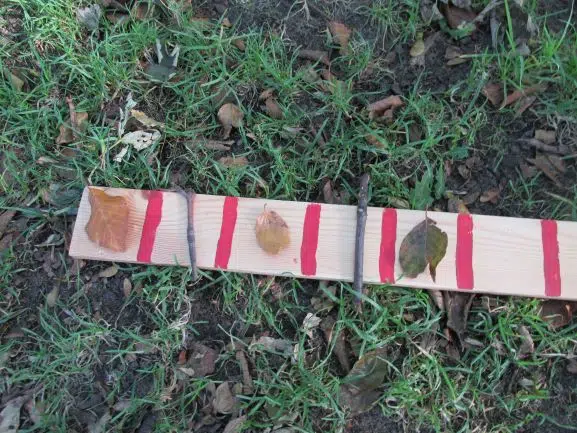
It is great to:
• Copy the patterns of others
• Extend patterns
• Use different combinations
This is one of 50 ideas in my in-depth article about the best 50 outdoor maths games.
14.Animal Skin Patterns
Resources – Pictures of animals skins, crayons or color pencils
There are many animals that have natural patterns on their skins. For example, things like zebras and tigers are great for this.
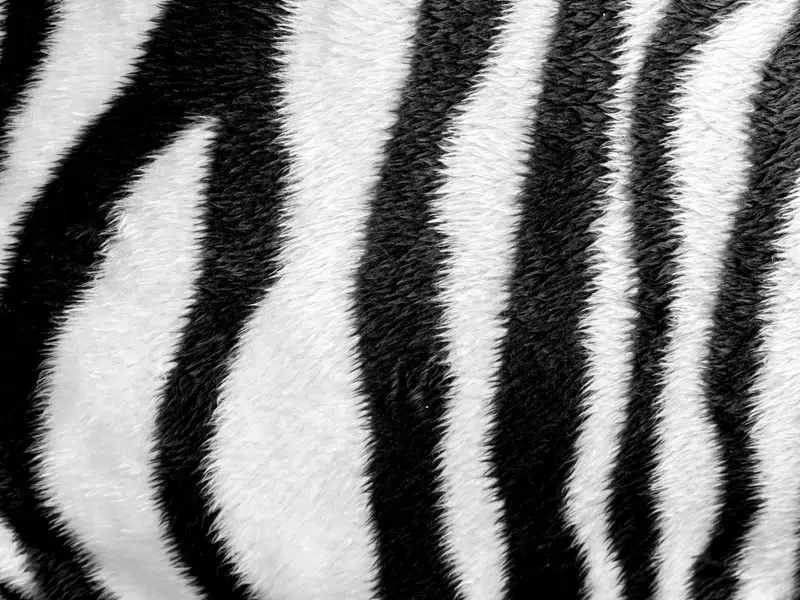
There are many ways animal skins can inspire learning, such as:
• Collages linked to the skins
• Paintings
• Pattern mark-making
15.Using Colored Number Stones
Resources – Number or colored stones
This is a great way of linking patterns to numbers. It makes a number line really visual, and also starts to teach them about odd and even numbers.
Children really enjoy using natural materials, and this has many benefits. Stones are a really simple resource that are cheap but also long-lasting.
Get some kind of stones and paint them in two different colors. Then paint some numbers on as well, so that the odd numbers are one color and the even numbers the other.
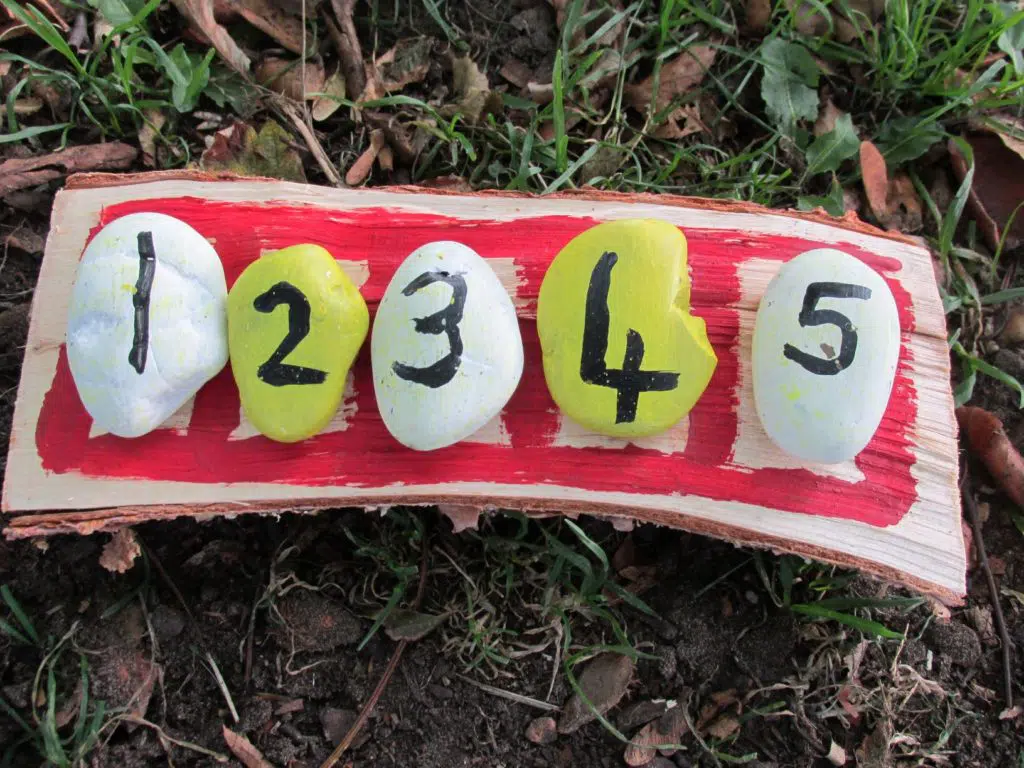
These are then great for ordering and seeing numbers in a pattern.
16.Using A Sequence Of Containers
Resources – A sequence of pots in a repeating pattern
This one combines patterns with some number skills as well.
Have two types of containers of some sort. It could be:
• Shot glasses (two different colors)
• Two colors of plastic pots
• 2 types of plant pots
Put the pots in a repeating pattern and then write numbers on with a permanent marker in order.
The idea is the children try to put the pots in order (e.g. 1-5, or 0-10). They can fill them up with something as well, to add the skills of matching numeral to quantity.
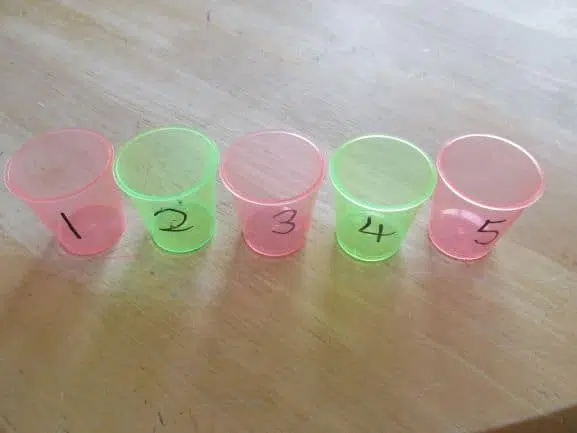
This activity is really visual – there are repeating patterns, a number sequence, and also it is the start of odd and even numbers as well.
17. Sounds!
Resources – Some kind of dance song
This is excellent fun. Put on some kind of song.
Then pick two types of noises – it could be a lion going ‘roar’, and a cow going ‘moo!’
Play the song and everyone does the two noises in a pattern – e.g. roar, moo, roar, moo!
They really love this, and it’s a really different way of experiencing patterns.
18.Pattern Dances
Resources – Some disco music
This is brilliant fun!
Put on some kind of dance music – anything with a good strong beat will do the job.
The dance will be a bit like aerobics. Pick two dance moves – it could be arms up then arms down.
Go for it to the music! Arms up, arms down, arms up…
Try out different types of moves. A really good way to ‘live’ what a pattern really is.
You can extend this one by using more unusual patterns – e.g. three or four moves in a sequence, and then repeated.
19.Construction Equipment
Resources – lego, duplo, megablocks, or whatever else the children like using
This is another good way of throwing in a pattern activity into something that children like doing anyway. It is also brilliant for their fine motor skills, which comes with many other benefits.
Starting them off with a tower or a wall in a pattern is a simple way to get going. Then they just try to complete the tower, using the same pattern.
Or you could have a picture that they could try to copy.
Or just let them go for it and see what they come up with.
Any construction equipment would probably work well.
Top tip – limit the amount of equipment to just two colors. This will really help them to understand the concept. Too much variation can lead to them creating just a random mish-mash.
20. Cut And Stick
Resources – Some pictures of at least two different things (lots of the same thing repeated)
This is a good one for cutting skills and fine motor, alongside building patterns.
Have two types of picture: for example, it could be about ten small pictures of apples, and ten pictures of bananas (all on one piece of paper).
Cut them out, and stick them in a pattern – apple, banana, apple, banana.
Create more complex patterns if the children are already confident with this concept.
21.Observing Patterns In Life
Resources – None
Patterns are all around us! Point them out to children whenever you spot them, and you can describe them together.

Some great places to see patterns in the world include:
• Clothes – either in shops or that people are wearing
• Furniture
• Wallpaper
• In posters and signs
• In nature
• In jewellery, or headbands, bobbles and the like
Top Tips For Patterns
- Make it as multisensory as you can!
- Dance, sing, and whack the patterns
- Start easy, but you can always make it harder
- Use lots of random objects and real-life experiences
- Talk about the patterns you see around you
Conclusion
Pattern-making is good fun, and really beneficial. It develops lots of communication skills, and sets children up for understanding number patterns later.
If you have found this article useful, then I would recommend trying out one of these…
